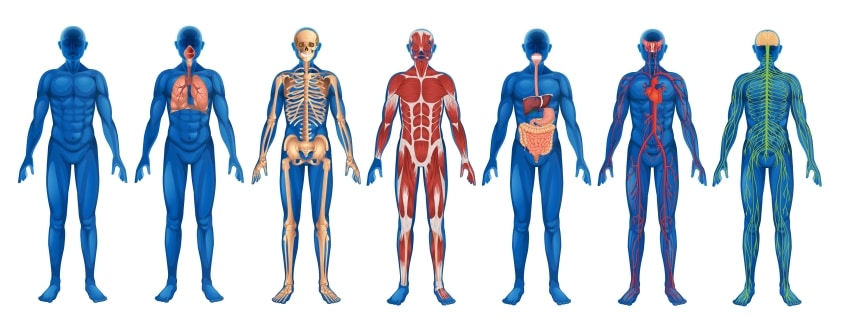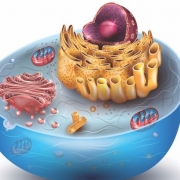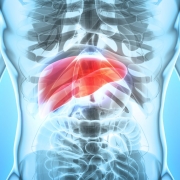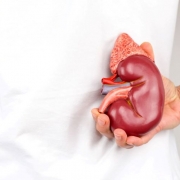The Human Organism: Breaking Down Your Body’s Structure

The human body’s capability is mind-boggling. Countless conscious and unconscious functions keep you moving, thinking, and…well, living. Like a well-oiled machine, it performs the same critical processes day after day. But of course, your body is not a machine—it’s an organism.
As it turns out, humans are pretty complex. And to understand how the body works, we need to understand its parts—that’s where this article comes in.
What is the Human Body Made of?
The human body is made up of trillions of cells. As the smallest living part of the human body, they’re made up of molecules which, in turn, are composed of elements. About two hundred different types of cells are found in the body, and each fulfills a different function. Red blood cells, for example, transport oxygen, while white blood cells help protect the body from infection.
And though it may seem strange, your cells are not permanent fixtures. Billions of cells in your body die every day—and billions are regenerated. This cellular turnover is a natural part of life within the human organism. Some cells, like skin cells, die and regenerate very frequently. Others, such as some cells found in bones, have much longer life cycles.
Not all cells work independently—some work in groups to perform larger body functions. But more on that in the next section.
A Closer Look at the Human Organism
While it is important to study cells and understand their roles, sometimes we need to look at the bigger picture. The structure of the human body can be viewed in several levels, each slightly more zoomed out than the last. They include: cells, tissues, organs, organ systems, organism. Let’s break them down.
- Cells: Your body is made up of trillions of cells—with more than two hundred distinct cell types that perform a specific function. As mentioned above, cells are the smallest living piece of a human body. And billions of your cells die and regenerate every day.
- Tissues: Similar cells that group together to perform a joint function make up body tissue. The four main types include connective tissue, epithelial tissue, muscle tissue, and nervous tissue. Each performs a general function but can also be broken down into specific sub-tissues with more defined functions. Muscle tissue, for instance, contracts and expands to move parts of the body—this is a general function. While cardiac muscle is a tissue that performs a specific job: contracting and expanding to pump blood through the body.
- Organs: When two or more tissue types team up to perform a specific function, they form an organ. Although most of your body’s organs contain all four types of tissue. Organs perform specific tasks necessary for your body to function. The heart, for example, pumps oxygenated blood throughout your body. Your lungs bring oxygen into your body and expel carbon dioxide. And your liver helps remove toxins.
- Organ systems: Groups of organs that work together form organ systems. For example, the brain and spinal cord are two distinct organs that contain nerves that transfer information throughout your body—both belong to the nervous system. The human body has eleven organ systems: cardiovascular, digestive, endocrine, immune, integumentary, lymphatic, musculoskeletal, nervous, reproductive, respiratory, and urinary.
- Human organism: All together these smaller pieces create a single living entity—the human organism. From the cellular level to your organ systems, each part of your body performs functions with the same ultimate goal: keeping you living and healthy.
Five Organs You Can’t Live Without
While each part of the human organism fulfills an integral role, some are more important than others. The human body contains five vital organs you can’t survive without—your brain, heart, kidneys, liver, and lungs. Although its best to approach health and nutrition holistically, these key organs can help orient you as you study the intricacies of the human body.
More About Organ Systems
Now let’s take a closer look at your body’s eleven organ systems. As mentioned, each is made up of at least two organs as well as other tissues. Their unique body benefits are highlighted below:
- Cardiovascular system: Made up of three major components—the heart, blood vessels, and blood—this system transports oxygen, nutrients, and carbon dioxide throughout your body. It works closely with the respiratory system to bring oxygen in and eject carbon dioxide out.
- Digestive system: Your mouth, esophagus, stomach, and both your large and small intestines are the primary parts of this system, also called the gastrointestinal system. Certain nutrients are needed to survive, and thanks to your digestive system, your body can take in food and water, process it, and extract these vital nutrients.
- Endocrine system: Your hypothalamus, pituitary, and thyroid glands release hormones into your body to activate changes and guide biological processes. Think of this system as an inner-body communication network that helps to regulate growth and development, homeostasis (constant internal balance), metabolism, mood, reproduction, sexual function, and your sleep-wake cycle.
- Immune system: Not only does this proactive system defend your body against disease, it also plays a part in protecting it from pathogens. It includes your spleen, tonsils, thymus, and leukocytes (white blood cells).
- Integumentary system: Made up of your skin, hair, and fingernails, this system is responsible for protecting against external microorganisms and for keeping fluids within your body.
- Lymphatic system: Three organs—the lymph nodes, the lymph, and lymph vessels—help protect your body against diseases and infections.
- Musculoskeletal system: As the name suggests, this system’s primary function is to use muscles and the skeleton to support your body’s soft tissue and allow for movement. And it may surprise you it also includes cartilage, tendons, and ligaments, which help connect bones and muscles to each other and to other parts of the body.
- Nervous system: Composed of the brain, spinal cord, nerves, and sensory organs (skin, eyes, ears, tongue, and nose) this system’s primary function is to gather, transfer, and interpret the sensory information your body experiences. And, when necessary, it alerts other organs and systems. For example, if you see a car careening towards you (a visual stimulus), your nervous system may activate your fight-or-flight response, which tells your heart to beat more quickly, your lungs to breathe more rapidly, and your adrenal glands to release adrenaline.
- Reproductive system: This life-giving system is responsible for conceiving and birthing offspring. The associated organs include genitalia, fallopian tubes, the uterus, the prostate, and more. It’s also responsible for producing gametes (or sex cells) and sex hormones—estrogen and testosterone—which play vital roles in human development and growth.
- Respiratory system: The organs in this system—the lungs, larynx, pharynx, trachea, and diaphragm—are responsible for bringing oxygenated air into the body and expelling carbon dioxide. This vital system works closely with the cardiovascular system to provide your body with oxygen, which helps cells produce energy.
- Urinary system: Also called the excretory system, it utilizes your kidneys, bladder, ureters, and urethra to remove water and waste materials from your body and help to maintain pH.
Understanding the Human Body: An Ongoing Journey
The human organism is so complex that it might seem impossible to fully comprehend—especially with a single article. But learning its basic structure is your first step to understanding how your body works.
So don’t stop here! Use what you’ve just read as motivation to dive deeper into one of nature’s biggest marvels: the human body.













